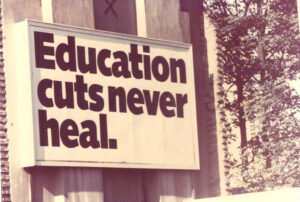
This article marks the fourth of a series of articles co-produced by Good Jobs First and NPQ, titled Checking Corporate Welfare, Stories from the Front Lines. In this series, we take a hard look at the current system, which enables corporations to write off $95 billion from their state and local tax bills each year—and how local groups are organizing in cities across the nation to challenge this system. In these articles, you will hear from community leaders who, armed with data, are developing innovative public campaigns that are beginning to contain these corporate tax abatements—and restore funding for public schools and local public services.
The divisions in Kansas City aren’t a coincidence. As in most cities in the United States, intentional racist redlining practices have plagued this place for decades.
There are a few dividing lines in Kansas City, MO. The state line separates the city from its namesake in Kansas. The river divides the city into north and south—with regions lying up north being more suburban in nature. And then there’s Troost Avenue, which has long been a racial and economic dividing line, with wealthier and whiter populations living to its west.
The divisions in Kansas City aren’t a coincidence. As in most cities in the United States, racist redlining practices have plagued this place for decades. During the first half of the 20th century, Kansas City-based real estate tycoon J.C. Nichols pioneered the use of housing covenants and deed restrictions to keep Black Americans, Jews, and other marginalized groups out of his suburban developments and to shape a certain type of city—i.e., a segregated one. His racist real estate practices created stark racial divides in the city and shaped subsequent redlining practices both locally and nationwide.
The effects of racial segregation and redlining are still seen in Kansas City, MO, today. Kansas City Public Schools (KCPS), which serves families south of the river and mostly east of Troost, is considered a “high poverty school district” and provides free breakfast and lunch to all students. The student population is more than 80 percent Black and Latinx, and it serves the highest refugee student population in the state.
Within KCPS boundaries, there is a significantly higher rate of evictions and homicide than elsewhere in the city. According to data from the KC Eviction Project, evictions within the school district’s boundaries vastly exceed that of the surrounding, more suburban districts. Unsurprisingly, KCPS has some of the highest rates of mobility in the state; many years nearly 40 percent of our kids change schools during the year, often due to housing insecurity.
Kansas City Public Schools is the only school district in the region without dedicated capital dollars—that’s led to nearly $400 million in deferred building maintenance. Meanwhile, over the past four years, $120 million has been diverted from Kansas City schools to support corporate subsidies.
Such instability—the result of disinvestment from certain neighborhoods and certain schools—isn’t a coincidence, and it has real consequences. Students often can’t show up mentally or physically in the classroom when they don’t have a safe and stable place to sleep at night.
This January, for the first time in 20 years, Kansas City Public Schools regained full accreditation. In the 90s, KCPS made national headlines as the first school district to lose full accreditation in the country. Superintendent Dr. Mark Bedell, who has led the reaccreditation effort over the past six years, was the longest serving district superintendent in decades, but he’s leaving. And his explanation to the city about why he is leaving emphasizes the work that remains: “The issues that have kept me up many nights are not ones I can solve as superintendent. I’m talking about racism, injustice, a lack of affordable housing, inequitable economic development practices, violence, and other systemic issues.”
Inequitable economic development practices in Kansas City have been laid especially bare in recent years. Both state and local governments are now required to report information on tax abatements, notably the amount of revenue given up. This information is gathered and reported in accordance with Statement No. 77 of the Governmental Accounting Standards Board (GASB). Good Jobs First, a corporate subsidies watchdog, has worked to track this information.
Corporate subsidies in Kansas City are costing our kids too much … Last year, the amount abated from schools in the KCPS boundaries was $37 million, which equals 23 percent of current local property tax revenues.
Tax incentives can be a valuable tool for cities and states to attract and grow businesses and promote redevelopment in distressed neighborhoods. However, without proper controls and oversights, they can also be harmful to communities by reinforcing segregation, causing displacement by gentrification, and diverting potential public revenues away from the schools and communities that need them most.
Indeed, the information provided by mandatory reporting and Good Jobs First and by tools such as the financial disclosure reports mandated by GASB have helped Kansas City Public Schools prove what we already knew to be true—corporate subsidies in Kansas City are costing our kids too much. From 2017 to 2020, the amount abated from schools in Kansas City increased by nearly 60 percent. Last year, the amount abated from schools in the KCPS boundaries was $37 million, which equals 23 percent of current local property tax revenues (about $160 million). Best practice tells us abatements shouldn’t be more than 10 percent of such revenues.
The data reveals a story that’s bigger than just the dollar amounts being diverted away from classrooms. It also tells us whose classrooms are hit the hardest. Per GASB 77 intel obtained from Good Jobs First and city government, we know that KCPS, a high-poverty school district that educates mostly Black and Latinx students, is losing more than a $1,000 per student each year. Two other regional school districts (Grandview and Hickman Mills), both serving mostly students of color, are losing more than $600 per student. Meanwhile, Kansas City’s suburban, mostly white school districts see much lighter impacts, losing between $18 and $400 per student per year.
Enough is Enough: A School Superintendent Says “No”
In spring 2020, BlueScope Construction approached Kansas City for a 13-year extension on a property tax abatement that was set to expire. Their attorney said the company would hop the state line, leaving Kansas City, if they didn’t receive additional public support.
In Kansas City, when development projects come forward seeking public subsidy, they are typically approved. BlueScope seemed headed in that same direction. The project had the markings of so many projects: an attorney who is a frequent flier at City Hall development hearings, and a threat to take business elsewhere if the city did not subsidize the investment.
With the vote looming, however, Bedell decided that this time, enough was enough.
This was in June 2020, on the heels of the protests that sprung up after George Floyd’s murder, when Black Lives Matter signs were showing up in windows, yards, and the street.
Bedell released a statement addressed to the mayor and city council members, reminding them that this 13-year ask would span a child’s first day of kindergarten in KCPS to their last day of high school.
“In the wake of the last month, I am sitting with how racism continues to fester in the culture, conversations and policies relating to business and economic development practices in our city. Frankly, I am exhausted with the development community pitting the city against the public entities that are doing the work of trying to give our students and their families access to the world they deserve. This is systemic racism.”
Sign up for our free newsletters
Subscribe to NPQ's newsletters to have our top stories delivered directly to your inbox.
By signing up, you agree to our privacy policy and terms of use, and to receive messages from NPQ and our partners.
Bedell reminded city council that school districts whose students are mainly white are treated differently. As noted above, tax abatement requested are made disproportionately in cities with low-income populations and large populations of color. As Bedell pointed out, Bluestone’s request was consistent with this trend: “A Kansas City company believing they can bring forward any additional request that diverts resources away from our students speaks loudly to the systemically racist real estate practices we have allowed to exist here … This request is a violent economic practice that would never be inflicted on the majority-white districts in the Northland.”
Bedell’s statement made it well beyond the email inboxes of city council members. Not only did the local press amplify his words, but social media exploded with shares from those familiar with the wonky world of tax abatement to people who were just getting a glimpse into such inequities via their friend’s Instagram story.
But his statement wasn’t the only one to land at council’s feet. Yes, some of the voices crying out about the unnecessary give away were familiar with the issue: such as the public library and the local community mental health fund, both of which are also funded by the property tax revenues that abatements cut into. A KCPS parent advisory group often raises issues with the fact that so much tax money goes to corporations instead of classrooms, and they didn’t hide from the conversation this time, either.
But some of the voices were newer ones when it came to abatements. I saw a leader in the local tenant union, which has since become vocal in opposing abatements for luxury apartments, insist that the city can’t say it values Black lives if it doesn’t value Black education. A Sierra Club organizer encouraged folks to reach out to their city council members to ask them to stop the giveaway.
The spotlight on the issue also had labor leaders pointing out that many of the projects that come forward asking for public support do not pay living wages. Even some smaller developers agreed that BlueScope’s ask was inappropriate, contending that the city needed to take another look at how and where they were dispensing public resources.
When time came to vote, council members did not shirk away from the conversation Bedell’s letter had started. On the council floor, a Northland councilmember agreed that they did things differently in the school districts in her neighborhoods. Another councilmember, a former school board president, asked: “When will we stop selling out our kids?”
Some councilmembers bristled at calling the deal systemically racist. One said that bringing up Blacks Lives Matter was “trendy or fun right now.”
Two councilmembers, both Black and representing a district where many KCPS families live, countered that pushback. One pointed out that the letter was critiquing the system, not specific people. The other replied that it’s “not trendy or cute or fun to be Black in America. We’re tired. What is wrong with us getting up and saying that there is an issue with this and not being met with this level of fragility?”
In a split vote, the council rejected the deal. The next day, the lead sentence in the local paper’s article about the vote noted that the deal had been criticized for being an example of how systemic racism influences Kansas City’s economic development. Two years later, despite the threat to move, BlueShield Construction remains in Kansas City.
Towards a Broader Public Conversation
The June 2020 city council vote kicked off a flurry of conversations about economic development practices in Kansas City. Over the next several months, in 2021, the council passed an ordinance limiting the use of tax incentives to 15 years. The city pledged to undertake a review of the scorecard used to grade development projects seeking public subsidy. Much work remains undone, however.
The “incentive reform” ordinance the council passed has multiple exemptions to the new time limit, allowing for approval of a slew of projects that do not conform to the new regulations. Developers continue to shop around for the best deal, often going to boards appointed by Mayor Quinton Lucas to get their abatements. Some of these boards, notably the Port Authority, do an in-house financial analysis instead of an independent, third-party one—a practice that precludes public input and feels disingenuous.
The city also continues to subsidize market-rate and luxury apartments with school district revenues. The apartments fall well outside the range of what is affordable to most poor and working-class people. Most KCPS families certainly cannot afford to live in the high rises (outfitted with pools and pet spas) that their kids’ classrooms are subsidizing. The scorecard that rates development has yet to be updated and implemented; the review process has now dragged on for more than a year.
The data has laid bare the disparities between Kansas City’s various neighborhoods and school districts. It has put words to the inequity we have seen play out in Kansas City for generations.
KCPS continues to be on and off the table. We still do not have a say over when and how our revenues are used in development projects, even though school districts in other municipalities and states have such authority. Lucas has still not put a KCPS representative on any of the mayoral-appointed boards that oversee most publicly funded development deals, though staff members of other, less impacted school districts hold seats.
There have been other successes. Council heard the cry when KCPS ask that we not be asked to subsidize a luxury hotel—especially in a market that has taxpayer-subsidized hotel rooms sitting vacant on weekends—and voted 11 to one against the subsidy request.
And the conversation is happening. The data has laid bare the disparities between Kansas City’s various neighborhoods and school districts. It has put words to the inequity we have seen play out in Kansas City for generations.
Last year, as city council moved to reduce the maximum period for tax abatements from 25 to 15 years, Councilwoman Melissa Robinson noted pointedly that for too long city government had been “prioritizing the needs of wealthy corporations over the needs of residents.” Robinson added, “Corporations have to pay their fair share to make our city work.”
Discussion has extended far beyond city council, and its echoes can be found in the ways people continue to talk about the city. In 2020, a young Black woman named Olivia Williams penned: “I’m a young, Black Kansas Citian planning to move — KC, why should I stay?” In her article, she pointed out that in Kansas City the phrase “urban development” “often means creating clean, new, modern, safe living and social spaces for decidedly white, middle- to upper-income populations.”
She notes that programs for Black youth are underfunded and that when development does move into Black spaces, it seems to mostly push the people already living there out. “I am not interested in remaining in a city that is not made for me. I want to live in a city that values its Black population,” Williams added.
The struggle to rein in corporate tax abatements and change un-development into community building is ongoing. To date, there have been some community wins, but the struggle is not yet won. What has changed, however, is that the millions of dollars that were subsidizing corporations largely out of public view are now visible here in Kansas City, MO, providing at least an opening for a very different approach to economic development—one that puts the needs of the city’s people, and especially the city’s children, first.








